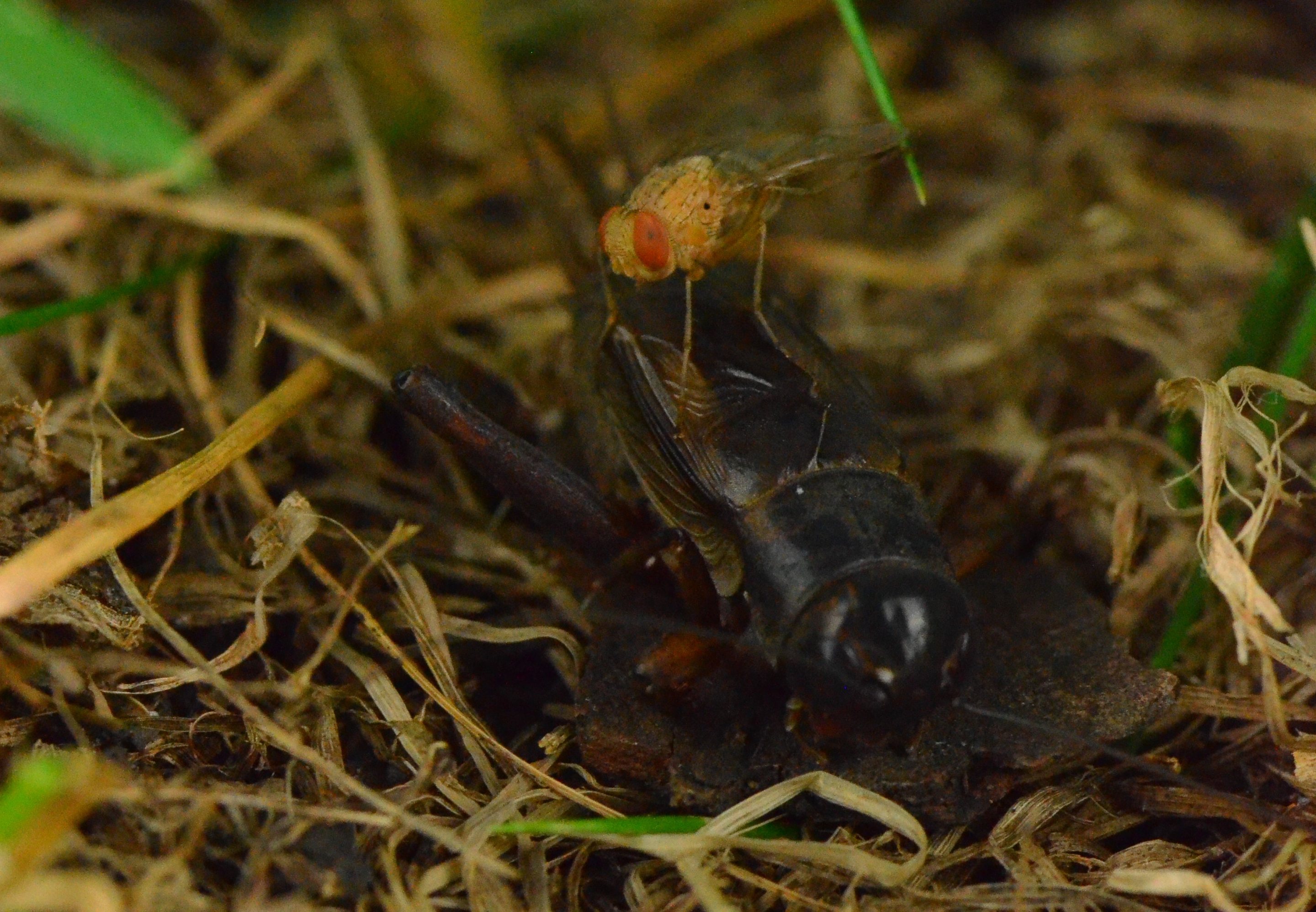For years, the mountains of Kauai were alive with the songs of male Pacific field crickets. They rubbed their ridged wings together to conjure loud pulses of chirps both short and long that sounded irresistible to faraway female mates—as well as to a deadly parasitoid fly. The fly Ormia ochracea, recently introduced from North America, triangulates a cricket's location from his call and lays eggs inside him that will erupt from his body as larvae about a week later in what has got to be one of the all-time worst ways to go. In 2005, researchers found the crickets on Kauai began to fall silent, as a mutation stripping the male crickets of the bumpy, noise-making ridges on their wings took over the population. These flatwing crickets were protected from the deadly fly but also bereft of their ability to find mates from afar. Soon, Pacific field crickets on the nearby island of Oahu also fell silent due to a totally separate wing mutation. The crickets had become a stunning example of rapid evolution: On Kauai, more than 90 percent of male crickets shifted to silence in less than 20 generations.
In 2018, the evolutionary ecologist Robin Tinghitella, one of the scientists who first documented the mute crickets, discovered that some males were breaking their silence with a new type of "purring" song. Earlier that year, the evolutionary biologist Jay Gallagher was interviewing to work with Tinghitella as a graduate student when she mentioned this new purring song. "All of a sudden, these light bulbs are going off in my head," said Gallagher, who previously worked as a professional composer and music producer. He wanted to analyze the cricket song for insight into how the evolution of song leads to biological changes in an animal.
Over the next three years, Gallagher—who is now at the University of California, Davis—Tinghitella, and other researchers tracked the biological changes in a population of field crickets on the Big Island. They found the evolutionary equivalent of chaos: Four different types of crickets with unique songs or morphology that emerged in the wake of the fly were now duking it out for mates. In a new paper published in the journal Evolution, the researchers conducted several experiments investigating which of these new crickets might come out on top, or vanish like their belting ancestors. "All this stuff is in a lot of flux," said Aarcha Thadi, a PhD student at the University of Minnesota who was not involved with the research. "Ten years from now, you could potentially be hearing crickets that don't sound like the original crickets at all."
After Tinghitella discovered the purring crickets, she received a grant to investigate the changes in the insects' preferences over time. The researchers planned to use the crickets living on the campus of the University of Hawai'i at Hilo as a control population; when the site was last sampled, the crickets were all ancestral singing males. But when the researchers visited the campus in 2019, the songs sounded ... different. "We were like, wait a second, these sound super weird. What's going on?" Gallagher said. A new morph had emerged: the rattling males. The researchers quickly realized the placid green campus grounds was home not just to purring and rattling males, but also males with small wings (hereinafter referred to as smallwings) and another type of males with curly wings (curlywings) that emerged partway through the study. "It really was the only place where we had this real fierce battleground with all these kind of newbies coming up and fighting for dominance," Gallagher said.
The different types of field crickets emerging in Hawaii are not new species, but morphs—groups of individuals that share particular anatomical or behavioral traits. And though scientists don't yet know the genetic underpinnings behind these changes, each morph appeared to be heritable, as their unique songs and wing shapes appeared over multiple generations. The smallwing and curlywing males are the easiest to spot, with stubby wings or squished wings that appear wavy, respectively. The rattling and purring males sound unique, as the rattlers' unique songs come from microscopic teeth-like structures on their wing, and the purrers have distinct gaps in their wing teeth. But without a microscope to discern these differences, the crickets look basically identical to each other and the ancestral cricket, which, for the record, is not from Hawaii but Australia.
The researchers visited the campus five times from 2018 to 2021 to survey how the cricket populations changed over time. "You often think that fieldwork is people trudging through five days with barely any water and food through the deep jungle," Gallagher said. But luckily for the researchers, these insects also enjoy creature comforts. "Our crickets love a good campus lawn," he said. "They love it if it's mowed periodically." The researchers scooped up males in miniature hotels—deli cups with a bit of rabbit food, dampened cotton, and a egg carton tent—a fitting getaway for insects that are often found living on the lawns of luxury resorts. "It's like a little spa vacation for them to refuel," Gallagher said. "I suppose that's not 100 percent natural, but I think if we're stealing them from their population for a couple days, the least we can do is keep them alive with what they need."

Over the three years of sampling, the researchers detected dramatic fluctuations in the makeup of these cricket populations that did not seem to veer in any particular direction. "Curlywing really increased, but then rattling came back, and ancestral lost a lot of ground and then came back a little bit," Gallagher said. Although certain morphs were clearly better-protected from the fly, this alone did not explain or predict these fluctuations. After all, the crickets didn't just need to survive the flies—they needed to find mates, and the newer morphs' songs did not appear to be as attractive to the females. "It all boils back down to natural and sexual selection fighting against each other," Thadi said. The researchers' results suggest that natural selection has a greater hand in the crickets' evolution than sexual selection, as the least-attractive, most fly-resistant morphs appear to be the most successful.
To test the effects of sexual selection, the researchers recorded the songs of the four different male morphs and played them simultaneously from separate corners of an arena. Then they placed a single female at the center and recorded which speaker she hopped to, which indicated the song she found most attractive. The females chose the song of ancestral males 70 percent of the time. When the researchers reared a generation of crickets from wild-caught females, they found a higher proportion of ancestral males than documented in the field. All this suggests that the ancestral males remain the most attractive crickets to females, whereas the curlywing morph was the least alluring (in the arena experiments, female crickets seemed to prefer silence just as much as the curlywings' song.)

To test which of these new males' songs were most attractive to the flies, the scientists first lured them in with a boombox serenade and soda bottle traps. "They're not just flying around," Gallagher said. "They only show up when you play the song that they like." The researchers played the different crickets' songs at dusk, when the flies come out to hunt, and would return an hour later to see which songs had trapped the most flies. (The flies do not receive the same spa-like treatment as the crickets but are still released.) In another experiment in the lab, the researchers placed a fly in a mesh cage with songs playing from four corners—rattling, smallwing, curlywing and ancestral, as well as silence—and recorded where the flies flocked to. Unsurprisingly, the flies had the same taste as the females, preferring the loud ancestral males over their quieter brethren.
The most recent data in the new paper was collected in 2021, meaning the battle among the male Hilo crickets might look very different today—it's possible that a new challenger has entered the ring, or even that an old morph has gone locally extinct. Thadi pointed out that no one could have predicted the specific mutations that would appear and propagate throughout the population, like the emergence of a curly wing—proof that evolution can take populations in unheard of or unexpected directions. "They could have evolved a wavy wing. They could have evolved a square-shaped wing!" she said. "As soon as we think we know what's going to happen, something new pops up that throws our predictions out the window," Gallagher said.






